We break down the myths and dive into research to ask the question, is dog sledding cruel?
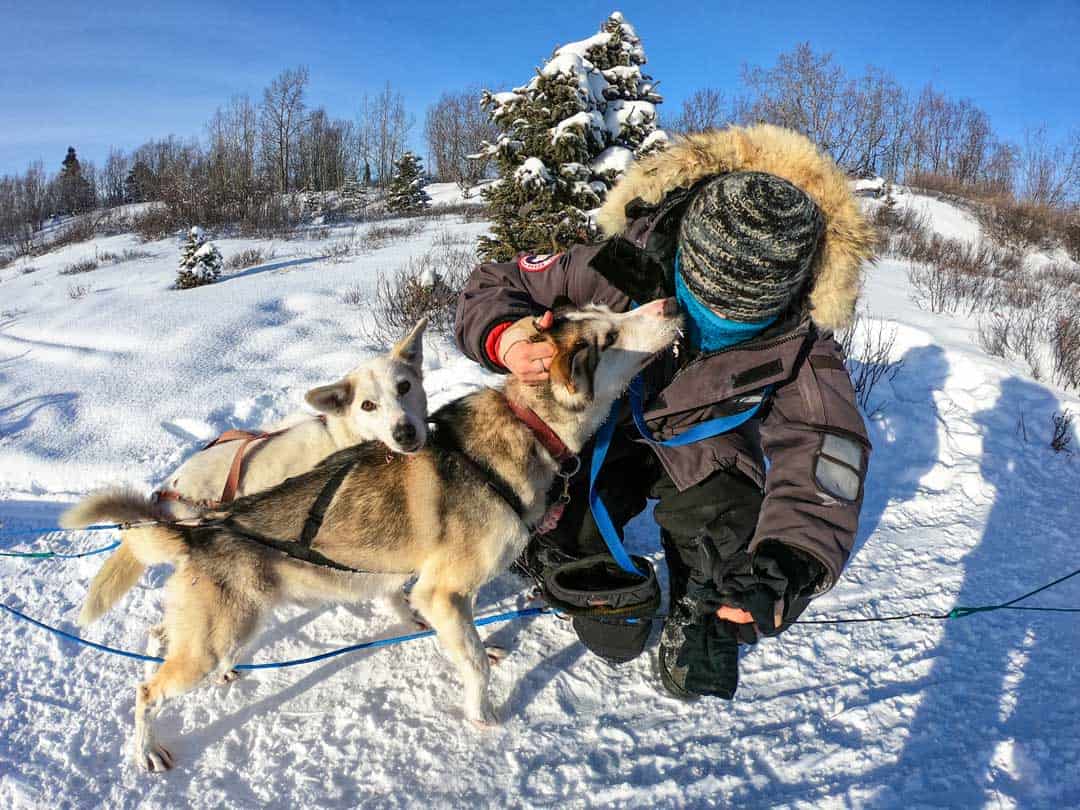
Is dog sledding inhumane? This is something we have always wondered, and the main reason that up until recently, we had never tried the activity.
Over the years we’ve heard horror stories about dog mushing, of dogs being overworked, or worse, and when we had the opportunity to try it for ourselves in Canada we were unsure of what to do.
We have always been big advocates for responsible tourism, especially when it comes to wildlife encounters and the fair treatment of animals.
We’re heavily opposed to activities such as elephant riding, close-up experiences with large cats and other similar tourist wildlife attractions, and the idea of using dogs to pull us across the snow just didn’t sit right with us.
It’s against our nature to jump to conclusions without doing proper research though, and so we began looking into as many stories as possible.
Our first round of research came up with some sad results. The Iditarod race in Alaska, perhaps the most famous dog sledding race in the world, had a tragic history of dog deaths, with 107 gorgeous pups perishing in the 1997 event alone.
Then there was the horrific story of the dog sledding outfitter in Whistler, who were caught putting down 56 of their dogs after the Winter Olympics, as bookings had fallen and they could no longer afford to feed them all.
Instantly the activity of dog sledding seemed like something we couldn’t partake in. But then again, these were the two most famous negative cases which we had already heard about. What if those two events didn’t truly represent the entire industry?
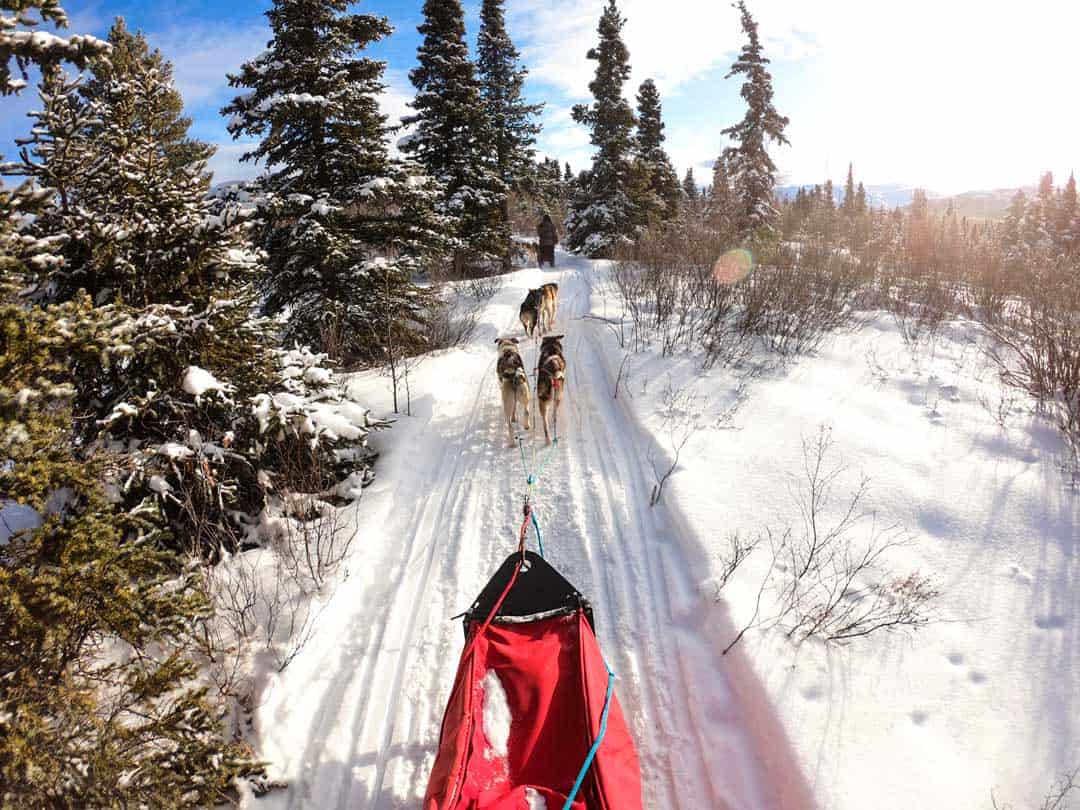
Luckily we continued reading, and what we found was much more uplifting. Countless vets and dog sledding companies swore that the huskies actually love mushing, and that each pup was treated extremely well with regular veterinary check-ups, lots of rest breaks and healthy food provided.
We also chatted to a few friends with similar morals and ethics who had been dog sledding abroad, and they all felt fine with their choice to go ahead with the activity.
The fact of the matter was the more we dived into whether or not dog sledding is cruel, the most information we got saying that it was nothing of the sort.
After all, if riding a horse was considered totally fine, why would dog sledding be any different if the dogs were capable and properly looked after?
Torn with what to do, we decided to go ahead with it and make up our own decision. What we found was simply amazing.
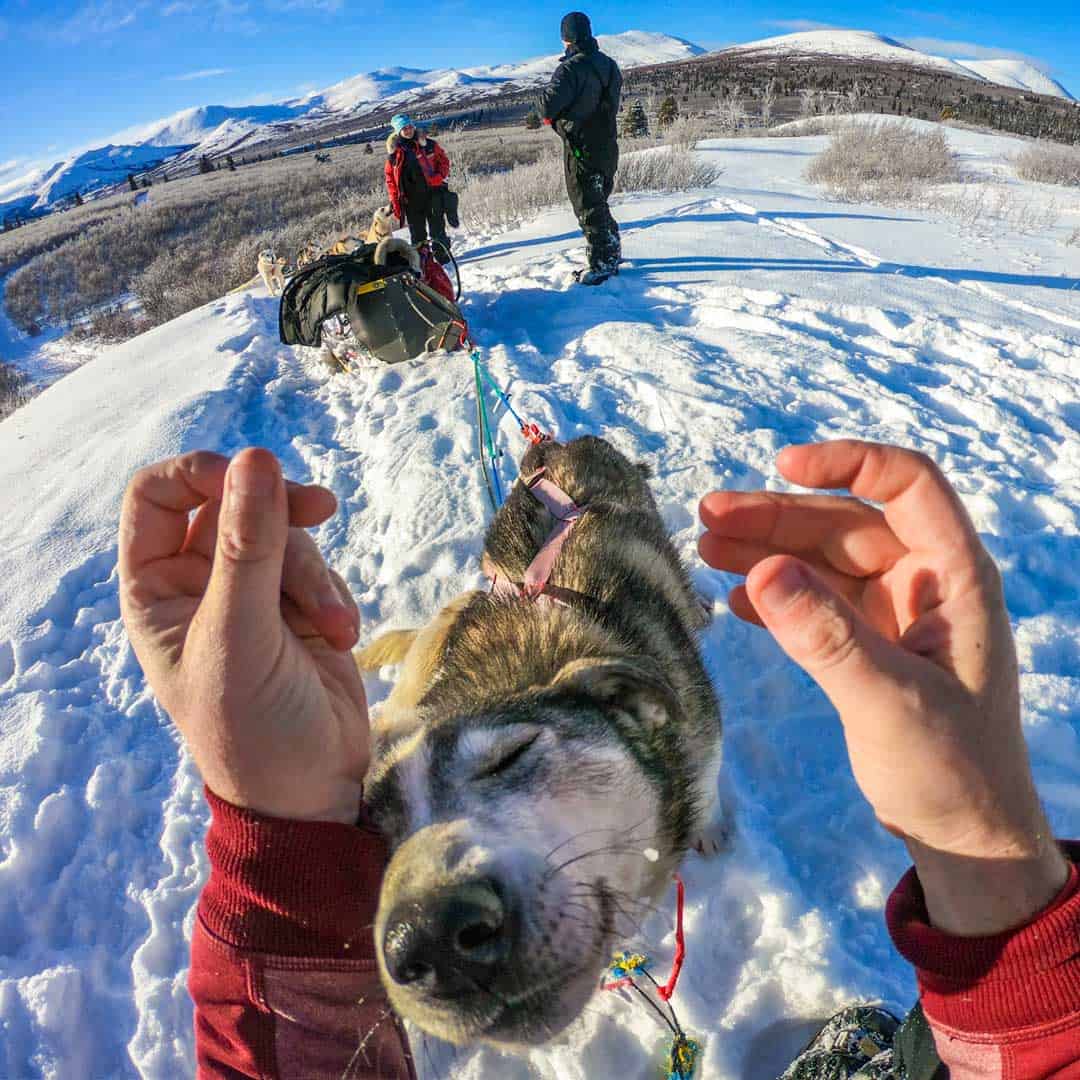
Table of Contents
Is Dog Sledding Cruel? Our Personal Experience
We travelled to the Yukon in Canada’s far north and signed up for a 4-day dog sledding tour with Sky High Wilderness Ranch. These guys were known for being of the best dog mushing operators in the country, and we couldn’t wait to check it out.
Our timing to Canada couldn’t have been any better for this research, as we actually landed in Whitehorse the night before the Yukon Quest started.
This is one of the most challenging dog sledding races in the world, but unlike it’s infamous counterpart the Iditarod in Alaska, the Yukon Quest isn’t plagued with horror stories.
In the morning we wandered down to the Yukon Quest starting line to check out what the atmosphere was like, and most importantly to see how the dogs were doing.
In the yards were dozens of trucks and sleds, and there were countless gorgeous dogs getting prepared for the race ahead.
We chatted with quite a lot with vets and racers at the Yukon Quest when we were walking around at the start of the event, and they all assured us that the dogs genuinely loved racing, and were never pushed beyond their capabilities.
Watching the lead mushers play with their dogs also seemed to us as though they sincerely loved their pets, and weren’t treating them purely as tools for their trade.
We watched one man spend nearly 5 minutes with each of his dogs, lovingly patting and massaging them, and the smiles on the dogs were undeniably real.
Our feelings about dog sledding were improving, and it only got better once we headed off for our own adventure.
From the moment we arrived at Sky High Wilderness Ranch it was apparent that the owners and workers loved the dogs like family members.
Everywhere we looked were people playing with the dogs, giving them snacks, hugging them and showing affection. It wasn’t an act for the tourists, here the dogs came first.
When we headed down to the yard to meet the sled dogs we were at first confronted to see they were all chained up to their pens (a timber box with hay for insulation).
As we got to know more about the sled dogs though we learnt that it was necessary. Dogs are pack animals after all, and in such a high energy place if huskies were allowed to walk around on their own they would inevitably end up challenging each other, leading to fights and injuries.
Their pens were basic, but provided plenty of warmth and protection from the elements in case of real bad weather.
One of our first concerns was that the dogs were left outside when the mercury plummets to -40. However huskies are blessed with an extremely thick coat of fur, and even when it was that cold we never saw them seek shelter or shiver. Rather they could be found rolling around in the snow and ice, loving every moment of it.
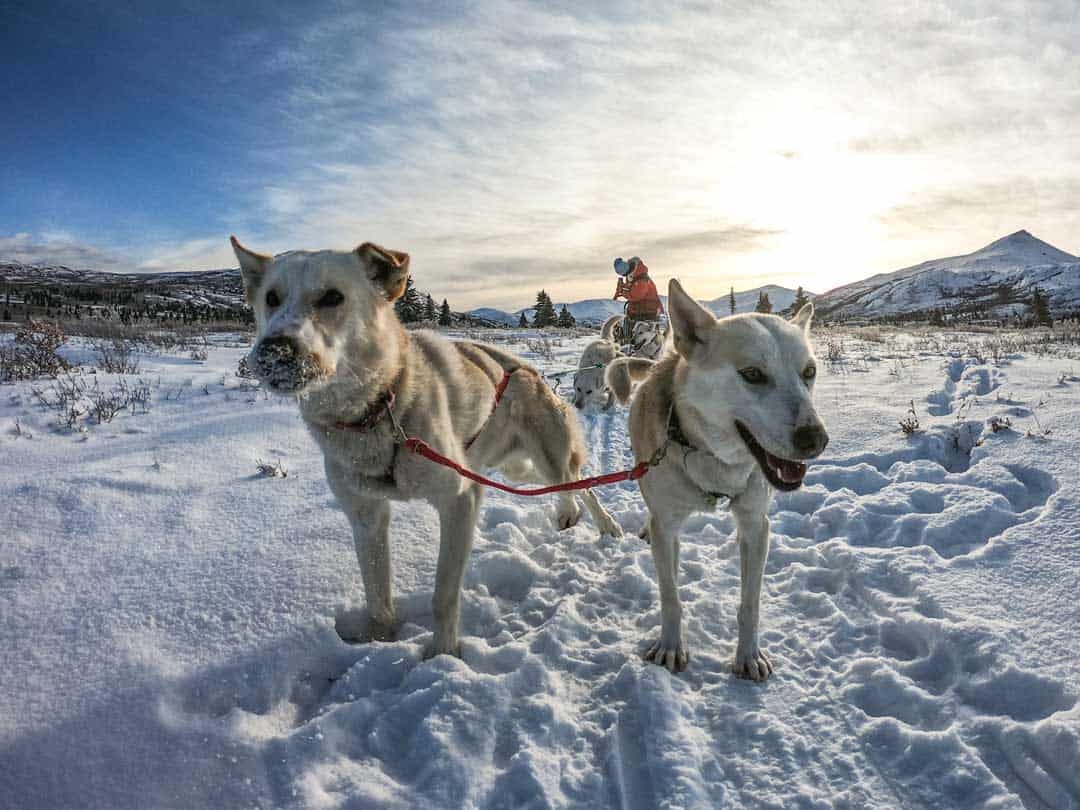
The older sled dogs that were retired roamed around freely, living out their golden years in peace with the freedom to go where they want, whenever they want.
We asked if the dogs at Sky High Wilderness Ranch were ever given up for adoption, but were told that it wasn’t possible as they had grown up on the property and only knew a life of mushing.
They were far too high-energy for somebody from the city to take into ownership as standard pets. That’s why they lived out their days in the world they had always known.
When it came to the actual mushing, this is where we really saw how much the dogs loved the activity.
As soon as we would walk up towards their pens with a lead in hand, the dogs would excitedly jump up and down, pulling on their chain towards us as we got closer. The happiness in their faces was irrefutable.
Once we collected them and took off the chain to their pen they basically dragged us towards the sled-loading area. They knew what they were doing, and wanted to do it.
It was the same once we started getting them prepped for the day. They would immediately calm down as we put on their harnesses, allowing us to lift their legs through the loops (or even lifting them already to help us).
At the final stage, getting ready to go, we would tie them to the sled. At this point the dogs turned into mushing machines, jumping in the air and trying the hardest to drag the sled forward. We had to have the anchor firmly in place, or else they would be gone before we had a chance to load ourselves on.
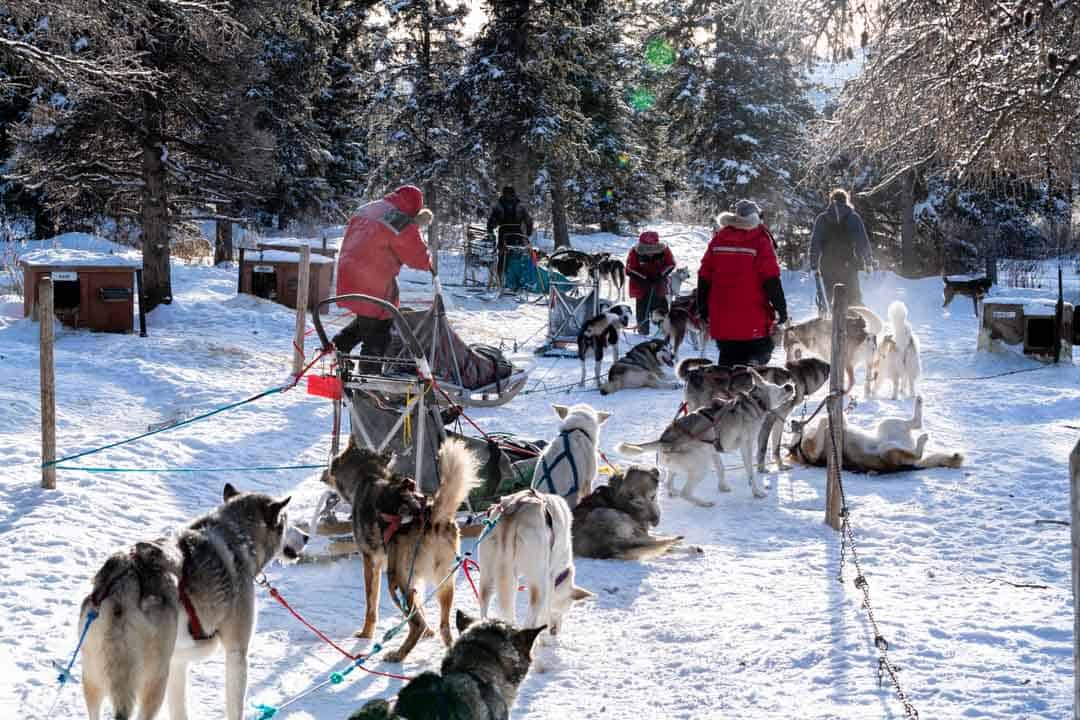
Once we were out on the trails the dogs kept a steady pace, constantly moving forward and looking back to see if we were ok.
Our guides were very strict on us that if we ever came to an uphill section, we were to get off the sleds and push them to assist with the dogs.
Likewise if we were going downhill we must constantly be leaning on the brakes so we didn’t get out of control and accidentally run into the backs of the dogs.
We were under instruction to always be watching the sled dogs, making sure the ropes didn’t get tangled up, and to immediately let the guides know if we noticed one dog leaping or slowing down.
Dog sledding was a fun activity, for sure, but it was not to come at the expense of the dogs’ health.
When the days were over we’d take the dogs back to the yard, feed them, give them massages and make sure they were safely back in their pens.
We spoke at length with the guides and the owner of Sky High Wilderness Ranch, Jocelyn LeBlanc, about the perception that dog sledding was cruel.
They all agreed that there has been some tragic examples in the past, but that these were actually quite unusual. The dogs were their livelihood, and without their wellbeing they couldn’t run a business either.
Customers weren’t foolish either. They could tell if something didn’t feel right the minute they stepped onto the property or took one look at the dogs.
It was also obviously clear that these people genuinely loved their dogs. They knew them all by name, they were always playing with them, and were constantly showing affection.
Our personal experience at Sky High Wilderness Ranch was nothing but positive, and it completely convinced us that this was a perfectly responsible activity.
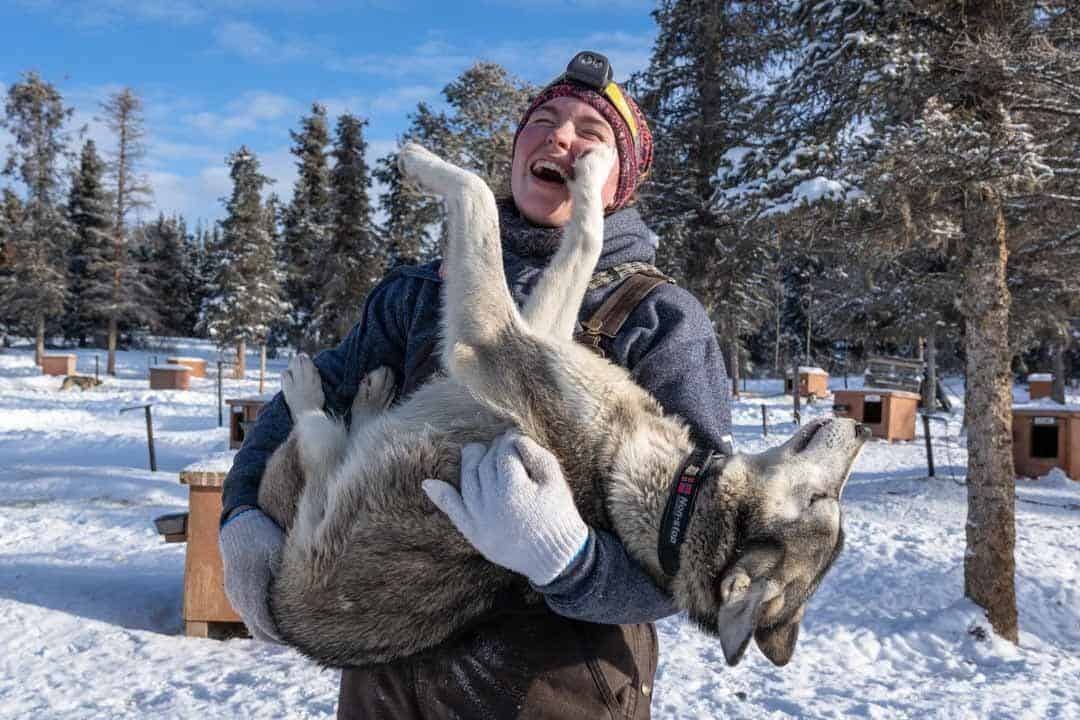
What About Other Places?
During our next couple of weeks around Canada, we travelled to Quebec and Banff, two places that were also famous for dog sledding tours.
While we didn’t join any new tours on this trip, we did visit dog sledding company in Quebec and spent some time chatting to the staff and owner.
It was the exact same experience as when we were Yukon. These people put their dogs on a pedestal. The owner even adopted dogs that the RSPCA were going to put down, even though they couldn’t be put to work, purely so she could give them a wonderful life at her property.
The reason we didn’t go sledding there was because it had snowed so much the night before. “It’s too much work for the dogs to pull through this much snow, better to give them a rest day and give the customers their money back,” she proudly said.
While we were exploring the best things to do in Banff, we joined a company for a day of ice climbing and asked the guide if had any experience dog sledding.
“I’ve never done it myself,” he shared, “but I have a few friends that work at dog sledding companies and the dogs absolutely love it. They’re born for it, and they have a really good life!”
During our questioning we never came across another story of sled dog animal cruelty outside of the two examples we had seen before. In the end we made up our mind. Is dog sledding cruel? Not in the slightest.
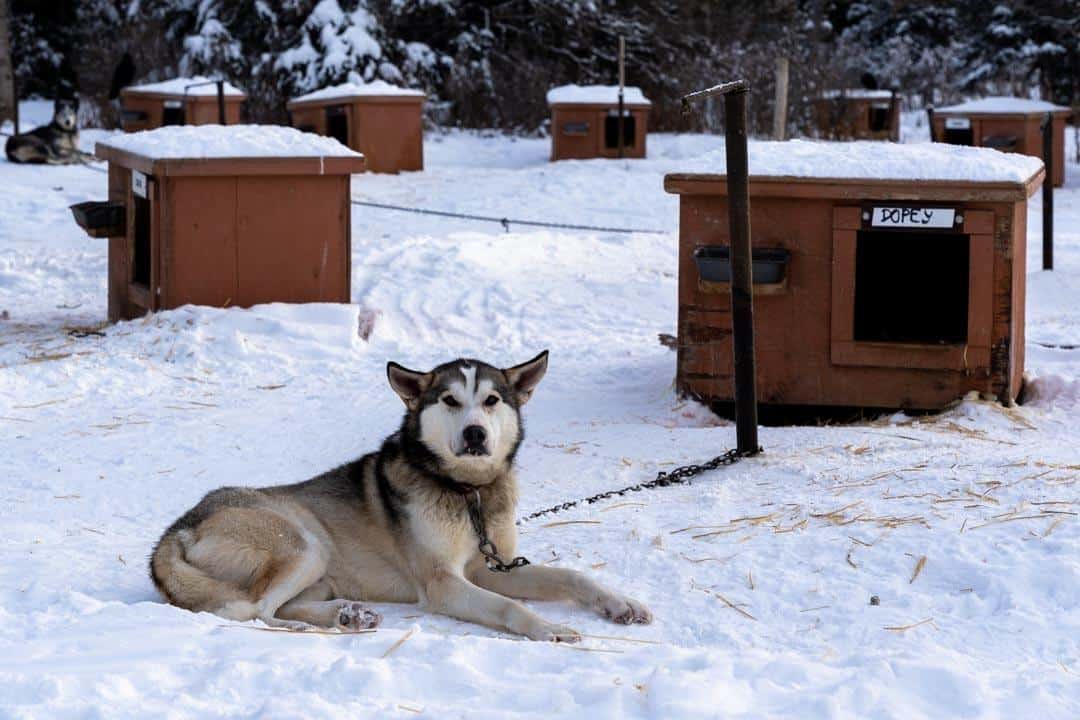
Can the Dogs Handle Pulling Sleds?
This is often the question people ask when considering whether or not dog sledding is inhumane. Here’s what we found out.
The dogs that are used for sledding are mostly huskies, or very similar breeds to huskies, and these dogs are well and truly born to mush. It’s in their blood.
They are strong work animals, and given the opportunity they will run for days without stop. They have so much energy to burn that the crave exercise.
As for the added weight of the sleds, this is why dogs are always put in teams of 4, 5, 6 or even more, depending on how many people will be riding in the sled.
Once the sled starts moving as well, it’s all about momentum. It’s easier to keep something on the go once it’s already moving rather than pulling a stationary object.
For this reason whenever the sled takes off with the dogs, the person in control jumps off and pushes as well to assist the dogs. The same is done with uphill sections – the human pushes so the whole job isn’t left to the dogs.
What About the Cold?
These sled dogs have very thick fur that is meant for living in sub-zero temperatures. While we might need plenty of layers at -20, these dogs barely feel the cold at that temperature.
When it gets really cold though (-40 for example), the guides will often put little jumpers on them, and sometimes booties to protect their feet. These aren’t necessary, but they do provide a little bit of extra comfort for the dogs.
Would We go Dog Sledding Again?
As we mentioned, we are very much about responsible travel and sustainable tourism. We are vehemently opposed to any kinds of animal mistreatment, and will always use our platforms to bring awareness to these negative activities.
Dog sledding though is anything but. Based on our experiences and research, we would say dog sledding isn’t any worse than riding a horse. In fact, the dogs are probably treated better.
If anybody ever asks us, “is dog sledding cruel”, we can strongly stand by our experience and say that we don’t believe it is in the slightest.
That being said, always do your research on any companies you choose to join for animal activities.
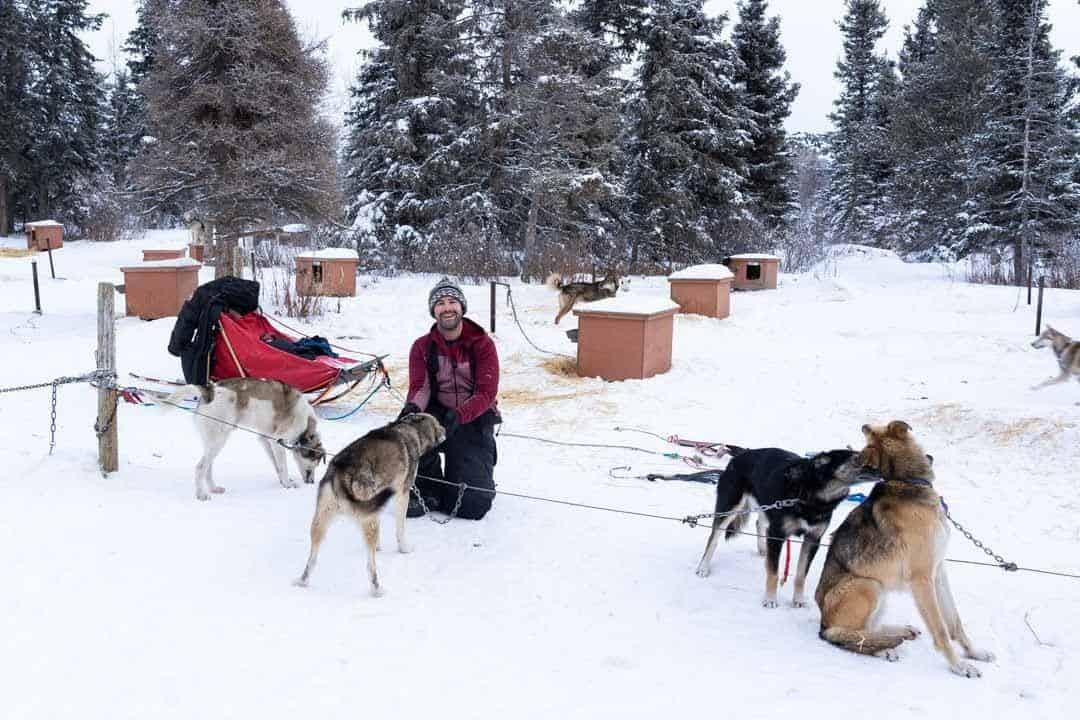


20 thoughts on “Is Dog Sledding Cruel? The Truth About Dog Mushing Tours”
I am so glad to hear that Canada treats its sled dogs so well. Just coming through Greenland and it is not coming across positively at all, rather heartbreaking. Info from dog team owners….. female puppies are killed, retired dogs shot, and not a vet to be found in greenland as “there is no money in sled dogs, strictly recreational, so owners wont spend money on a vet”. In my opinion, commense sense and a sense of human decency, should compell them to let this barbaric sled dog culture go.
It is a good article for awareness.Thank you guys for your common sense about working dogs!
I go both ways here I have a West Highland White Terrier 13yr.old and he loves rolling in snow but he stays inside at night but I didn’t see or hear you say how any of these dogs would be protected(many pictures of them on chains your pictures I guess) if on chains they were attacked. Does some(horse)sorry human stand guard over night and protect them anytime you see any animal chained ITS CRUEL PEOPLE!!!!! didn’t you guys have pets growing up? I’m sure you love animals but I agree with some of the other comments 4minutes or 4 days isn’t enough research or maybe you could just interview all the smiling dogs. I’m sure they have told their handlers. You guys are trying to do good and for that I THANK YOU.
Totally agree with the comment but not with the article and some other comments that were written. Someone said work animals and pets are not the same, who made them a work animal? were they born to be working animals? What happens to the dogs when its not peak season? is there continuous breeding to get huskies? so with the same argument is seaworld ok? Animals should be kept free not make them work!!! Unfortunately articles like this make a really bad impact as people only see the surface of the whole industry. Want to go on snow, rent a snowmobile!!!!
“were they born to be working animals?”
They literally were born to be working animals. It is hard coded in their DNA to want to do this. These aren’t humans, you can’t apply your own thought process to an animal. They don’t want the things that we want, they don’t feel the way we feel. It is in their blood to want to be out there pulling sleds. They are happiest when they are pulling. I highly doubt you’ve ever gone, and I REALLY doubt that you’re involved in the industry and sport. What would you rather have the dogs do? Lounge around all day? They would go insane. Not be born? Why? The dogs are happy, they enjoy their life.
You simply don’t know what you’re talking about and are applying your human emotions to animals that work mainly off instinct and purpose.
“What happens to the dogs when its not peak season?”
What’s funny is you don’t know the answer yet assume it’s a negative. What, do you think the dogs sit in the kennel for months? Their muscles would atrophy and they would become a liability to their job. They obviously get regular exercise.
“is there continuous breeding to get huskies?”
Yes…yes dogs breed. That’s how you get puppies. Dogs also die. So unless you thought dogs to be immortal I don’t know what you’re getting at here.
“so with the same argument is seaworld ok?”
What a terrible comparison and I feel stupid even acknowledging it. The animals in Seaworld are essentially prisoners locked in a cage for their entire lives, doing thing entirely unnatural to them and living in what could be considered torture. These dogs are happy and do what was basically encoded in their DNA at birth. Again, you’ve never been, you just want to complain about shit that you don’t have any idea about.
“Animals should be kept free not make them work!!!”
That is probably the dumbest thing I’ve ever read. You realize that dogs were domesticated by man, right? And the various dog breeds are derivatives of ways that we can work with them to accomplish a task. Some dogs were bred to herd, others to hunt, others to fetch, and others to pull a sled. Dogs are an animal of purpose. They were bred for work, and in turn they love their work. If you take away the dogs purpose, the thing they love to do, then YOU are the cruel one. You have no idea how dogs think and operate.
“Unfortunately articles like this make a really bad impact as people only see the surface of the whole industry.”
And what, you’re an expert? You’re obviously ignorant not just to the industry, but to dogs and their various breeds. You literally have no idea what you’re talking about, and to anyone with half a brain it’s obvious.
So to summarize, you and Donna should leave the thinking to people with an above room temperature IQ.
thank you
thanks for the information 🙂
Hi! Great article! Working dogs and pets are a completely different subject. For example, not a single livestock guardian dog will normally work if the owners “spend quality time playing with each dog everyday” or “allow their dogs in their homes to sleep as part of their family”. It’s just not possible. Thank you guys for your common sense about working dogs!
Great article guys! Well articulated and great perspective. I think most people can obsess about elements of dog sledding/mushing that they do not understand, and think that it is negative (i.e. “Why leave the dogs in the cold..?”).
A firsthand experience like you guys had debunks these myths quickly. Living in in-land Alaska, I have so many friends and neighbors that are dog mushers — and I can say without a doubt that they all love and take great care of their dogs.
From my experience, people treat their dogs like their children. Yes, some people abuse their children, but most really love their kids and sacrifice for them.
And what you guys saw is so true in all of the contexts I have seen: dogs absolutely loving their life, loving the snow, loving the thrill of running, loving their life!
This is purely out of curiosity, as I’m in support of dogsledding when done ethically and would like to recreationally partake in it in the future. I just noticed things that don’t line up in this story.
(1) You mentioned they told you the chains were there to keep the dogs from exhibiting pack mentality and attacking each other in their excitement, but that older retired dogs were allowed to roam free. Being that these are all the same kinds of animals with similar genetics, wouldn’t the older dogs be attacking each other constantly if given that chance? It seems more like chaining would be a preventative measure towards a stressed animal fighting another one, not towards happy, well-kept animals, who as you stated, once retired, were off chain.
(2) You wrote that customers weren’t foolish either, but that also seems extremely contradictory. Several businesses in the past who were found to be abusing their dogs had great payout; this was why it took so much effort from environmental groups to get them to shut down or transfer the business ownership. People in these communities actually expressed confusion and outrage when these companies were accused of abuse, not towards the companies but towards the accusers, until there was sufficient evidence that abuse had taken place. That seems a glaring contradiction of the idea that customers would notice something being off. If anything, the actual proof there supports the notion that these companies are great at convincing customers they’re for the dogs.
(3) Generally, it seems the only places that reassured you or gave you information on how okay the business practice of mushing was were pro-business websites and the kennels themselves. This doesn’t seem like informed research as much as it seems like the most heavily biased sources possible. Yukon Quest vets and mushers, along with everyone else interviewed, are profiting directly off of big company mushing; to say anything negative about it would be to screw themselves over financially. I’d be more reassured by this article if there were sources from the other side too, especially from scientists and animal welfare groups, agreeing with the stance that these practices are alright.
Again, I love mushing. I’m looking into getting into the sport myself, on a non-commercial level. I have several Iditarod mushers I adore. But I feel like this article isn’t so much a case of doing research as it is a case of reinforcement of already held beliefs. I’m not on the ‘anti-mushing’ side of this, obviously, but it seems really suspicious that when it comes to these massive kennel operations the only positives I hear come from the active customers and kennels themselves. A lot of credibility feels lost when we’re only presented with one side of the argument, direct from the mouths of the people being accused of cruelty. They have absolutely no reason to tell you they’re doing anything wrong at all, nor do their friends or family.
I just feel this article contradicts itself several times on serious enough points that it comes across as one written to make people who have gone on mushing excursions feel more justified on their choices, not one with any convincing points that would make a curious and skeptical person calmer about the ordeal.
Again. I love mushing, I plan on doing it with a muti-dog team in smaller races. I have mushers I idolize. But this article feels like it’s bringing up more points of doubt than calm, with the sources being financially biased and almost every reason for keeping the dogs in bad conditions contradicting itself just a few lines later.
I found this article completely repugnant. If the “researchers” knew anything about dogs, they couldn’t have so easily justified an industry that uses dogs for the sole purpose of making a buck. And to compare dogs to horses is comparing apples to oranges. Animal researchers, specifically canine researchers, have discovered that the majority of dogs tested prefer human company over canine company when given the opportunity. And over the thousands of years of domestication, dogs have learned to be pleasers to secure their place along side humans, not just for food or other reward but for the company of their person. The idea that one man spent “nearly” five minutes petting his dogs is some kind of benchmark for a loving relationship with an animal, specifically domesticated to be a companion, is laughable but also sad.
“Countless vets and dog sledding companies swore that the huskies actually love mushing, and that each pup was treated extremely well with regular veterinary check-ups, lots of rest breaks and healthy food provided.” Of course sledding companies are going to swear that their dogs “love” mushing. They are biased! Furthermore, regular vet care, quality food and breaks hardly qualifies as markers for anti-cruelty. They take care of their property, their money machines, but do they allow their dogs in their homes to sleep as part of their family? Do they spend quality time playing with each dog everyday? I’m not talking about a few pets and tossing a stick either.
As for vets saying what dogs love, well, unless they have the credentials of an animal behaviorist or researcher, they are speaking an opinion and nothing more. One must question then whether the dogs “enjoy” lugging people around day in and day out, or are they just doing what they are conditioned to do like Pitt Bulls conditioned to fight. It’s why abused animals don’t always run when given the chance to flee.
And finally, the biggest misnomer is that a thick coat is some magic cloak that prevents frostbite to the ears and feet. And even if the dogs can sustain below freezing temperatures, how can any reasonable animal advocate come to the conclusion that the dog prefers to be left outdoors to endure the bitter cold? Yes, they may not be conditioned to indoor temperatures, but that doesn’t mean they couldn’t be, especially old dogs subjected to years of wear and tear to their joints. And their “reward”…to wander around the property going wherever they want, whenever they want. Is this how we should treat a loyal, hardworking family member? I think not.
Hi KT,
Thank you for your comment. As the “researchers” (Jarryd and Alesha, you must have not got to the end of the article as you would have seen our names) we did do our research. Have you been to this establishment yourself to do your research? I guess not.
As you would have read, we did not go on a short 1-hour tour. We spent 4 days at the property and learnt a lot about the dogs, the workers, the owners and the establishment. Yes there are horrible dog sledding companies out there, and that is why we say to people do your own research.
Everyone is entitled to their opinion based on independent research, and we respect that. Dog and horses are both animals, and apple and oranges are both fruit. I hope you are this vocal to horse racing companies as well. Take care
You don’t know the first thing about canines, obviously.
The thing is, mushing dogs are bred to do it. They love it. We have someone in our neighborhood who has a husky. They have a tiny yard, but they take the husky out pulling their skateboard for miles, and they love it. I’ve seen so many huskies and other sled dog breeds going crazy being cooped up inside a house. 2 mile walks just don’t cut it for them. Also, husky’s (and other breeds) bred to be sled dogs have coats way too thick for living inside (unless you’ve got AC that lowers the temperature down to at least 50 degrees Fahrenheit?) . It’s just not feasible to keep all the dogs inside. You’d need basically a mansion.
Good response. I agree completely. And let’s not forget the dogs that die when forced to run long races, as 107 did in the 1997 Iditarod.
I am not sold on your story. If those dogs are being treated so well how come they are so heavily chained in your photos and not let loose , these don’t speak of nice conditions
Think about it. Why are most pets (horses, dogs, cats, etc) kept secured at night? That’s because if they weren’t secured, they might: a) run away, b) attack each other as they try to show dominance over the alpha males or, c) be attacked by wild animals such as bears or moose if they wander too far from the safety of their pack. If you have more concerns about this, we suggest visiting a property that houses dogs for this activity.
”Is dog sledding cruel?” Well, let’s think about it a little bit. The mere image of seeing these beautiful animals living out their entire lives chained up to a pole, ”chilling” by their pen, as you so inoccuously put it, when they are not being used to pull a heavy load over kilometers in the freezing cold, saddens me beyond words. That you then have the nerve to say that it is ”not cruel in the slightest” is profoundly disappointing to me. Let me put it this way : do you think that you would like to exchange places with any one of them, for the rest of your life? I somehow doubt it. And don’t hit me with ”well it’s OK to use horses, so why not dogs?” My answer is : NO, it’s NOT OK to use horses either, or any other animal for that matter, especially if they have to be chained down or locked up, ”for their own safety”. There is still a loooong way to go in terms of basic animal rights and respect, from what I see.
You seem to be unaware of how animals die in the wild – they’re usually eaten while still alive. Unless you’ve got a group of humans who are eating a dog alive, that means that any dog (or animal) under your care is going to live a better life simply for the fact that they’re not going to GET EATEN ALIVE. Sled dogs are kept happy, fed and warm, otherwise, they’re not going to make it, and you’re not going to make it. It also seems like some people forget that this isn’t just a sport, it’s something that actually exists today as a form of travel.
Thank you! I had my concerns that dog sledding was not humane. I am most familiar with the horror stories your presented. Thank you for doing the research about the other side. I am a little more at ease.